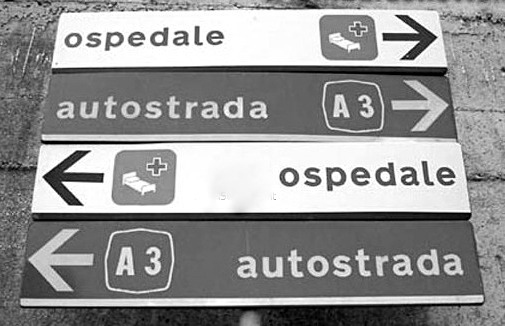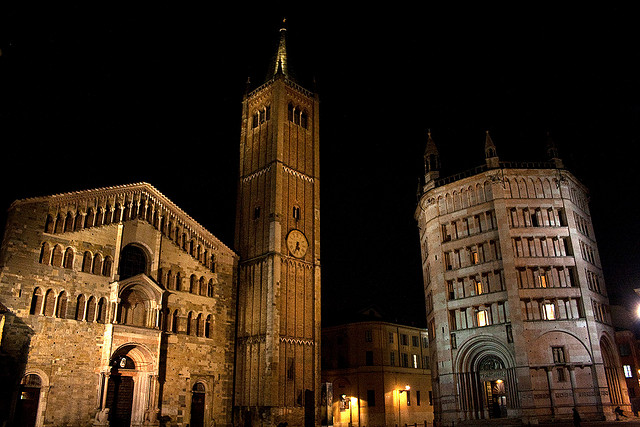Understanding Directions in Italian Posted by Geoff on Mar 23, 2015 in Uncategorized
Last week I published an article about Asking For Directions. The article itself was fairly basic, and probably not much different from what you might expect to find in a typical Italian phrase book. But now comes the real challenge … making sense of the reply!
To that end I’m going to provide you with a list of keywords and phrases to listen out for when someone gives you directions in Italian, followed by some examples of typical replies that you might hear. Obviously it’s impossible to cover every eventuality, but this should get you started.
Keyword and Phrases:
sempre dritto = carry straight on
fino a = until the …
fino in fondo = to the end
sulla destra/sinistra = on the right/left e.g. l’albergo resta sulla sinistra = the hotel is on the right
a destra/sinistra = to the right, e.g. giri a destra = turn (to the ) right
qui dietro = behind here
a fianco di = next door to
davanti a = in front of/opposite
la prima/seconda/terza a destra/sinistra = the first/second /third to the right/left
segua = follow (formal singular), seguite (plural)
passi = pass/go by (formal singular), passate (plural)
circa/più o meno/su per giù = around/about/more or less, e.g dopo circa cento metri = after about one hundred meters
prima di/dopo = before/after, e.g. prima del ponte = before the bridge, dopo il ponte = after the bridge
sopra/sotto = over/ under
l’incrocio = the crossroads
la rotatoria/la rotonda = the roundabout
il semaforo = the traffic lights
l’accompagno io = I’ll take you there
non sono di qua = I’m not from around here
Now, if you’re all sitting comfortably … on with the show. The two protagonists are Geoff, playing the part of a confused visitor to Italy, and Serena, playing the part of the helpful native.
1. Finding a Toilet:
Geoff: scusi, c’è un bagno/una toilette/un gabinetto qui vicino? = excuse me, is there a toilet nearby?
Serena: dunque, vada sempre dritto fino alla piazza … sotto i portici sulla destra c’è l’ingresso ad un cortile … vada nel cortile e il bagno è a destra. = well, continue straight on to the piazza … beneath the porticoes on the right there’s a courtyard … go into the courtyard and the toilet is on the right.
Geoff: scusi, dov’è il bagno/la toilette/il gabinetto per favore? = excuse me, where is the toilet please?
Serena: mi dispiace, non ce n’è uno qui vicino. Deve andare fino alla stazione oppure ad uno di questi bar = I’m sorry, there isn’t one near here. You’ll either have to go all the way to the station, or to one of these bars.
Geoff (in the bar): scusi, posso usare il bagno/la toilette/il gabinetto per favore? = excuse me, can I use the toilet please?
Serena: certo, è qui dietro, la prima porta a sinistra, ecco la chiave = of course, it’s behind here, the first door on the left, here’s the key.
2. Finding the Railway Station or a Bus
Geoff: scusi, dov’è la stazione per favore? = excuse me, where is the railway station please?
Serena: segua questa strada fino in fondo … deve passare due ponti … dopo il secondo ponte vada a destra e la stazione si trova sulla sinistra dopo circa trecento metri = follow this road to the end … you have to cross two bridges … after the second bridge turn right and you’ll find the station on the left after about three hundred meters
Geoff: scusi, mi può dire come arrivare alla stazione degli autobus? = excuse me, how do I get to the bus station please?
Serena: allora, prenda quella strada lì, continui per circa duecento metri … poi giri a destra, e al primo incrocio a sinistra = well, take that road there, continue for about two hundred meters … then turn right and at the first crossroads go left.
Geoff: scusi, dov’è la fermata dell’autobus per favore? = excuse me, where is the bus stop please?
Serena: è qui dietro l’angolo … davanti all’edicola = it’s right here round the corner … in front of the news stand
3. Finding a Museum/Gallery/Monument etc.
Geoff: scusi, dove si trova La Pinacoteca Nazionale per favore? = excuse me, where is the National Art Gallery please?
Serena: mi dispiace ma non sono di qua, però ho notato un ufficio turistico all’angolo di quella piazza lì = I’m sorry, I’m not from here, however, I noticed a tourist information office in the corner of that piazza over there
Geoff: scusi, come si arriva all’anfiteatro per favore? = excuse me, how do you get (literally: how does one get) to the amphitheatre please?
Serena: allora, prenda questa strada, poi prenda la prima a sinistra, vada sempre dritto per un bel po’ … ad un certo punto vede una piazzetta sulla destra … sul lato sinistro della piazzetta c’è un arco, quello è l’ingresso all’anfiteatro = well, take this road, then take the first left, go straight on for quite a way … at a certain point you’ll see a little square on the right … on the left side of the square there’s an archway, that’s the entrance to the amphitheatre
Geoff: scusi, quanto dista il duomo? = excuse me, how far is it to the Cathedral?
Serena: da qui il duomo dista su per giù mezzo chilometro, se vuole, anch’io adesso ci vado … l’accompagno io = the cathedral is about half a kilometre from here, I’m going there now, if you like I’ll accompany you.
4. Finding Your Lodgings
Geoff: scusi, mi può dire dove si trova L’Hotel Napoleone per piacere? = excuse me, can you tell me where the Hotel Napoleon is please?
Serena: dunque, l’Hotel Napoleone resta circa due chilometri fuori città … bisogna prendere l’autobus o un taxi = well, Hotel Napoleon is about two kilometres outside town … you’ll need to take the bus or a taxi
Geoff: scusi, come arrivo all’Albergo Senato per favore? = excuse me, how do I get to the Albergo Senato please?
Serena: okay, per arrivare all’albergo bisogna seguire via Garibaldi, che è questa qua a destra … poi, quando vede la fontana giri subito a destra e lo vede lì davanti = okay, to get to the Albergo you need to follow via Garibaldi, which is this one to the right … then, when you see the fountain turn immediately right and you’ll see it there in front of you
Geoff (in the car, stopping to ask a passer by): scusi, dove si trova l’ostello della gioventù per piacere? = excuse me, where is the youth hostel please?
Serena: l’ostello si trova di là, però quella strada lì è senso unico, quindi occorre proseguire dritto fino alla rotatoria, e lì prendere la seconda uscita … passi sotto il ponte della ferrovia … e l’ostello resta altri duecento metri più avanti sulla destra = the hostel’s over there (pointing), however that street is one way, so you’ll need to carry on to the roundabout, where you take the second exit … go under the railway … and the hostel is two hundred meters further on the right.
Now, don’t forget, in case of emergency simply say: scusi, non ho capito = I’m sorry, I don’t understand

Build vocabulary, practice pronunciation, and more with Transparent Language Online. Available anytime, anywhere, on any device.






Comments:
Keane:
Molto utile! Ma perche’ e’ “l’accompagno io” invece di “ti accompagno io” o “La accompagno io”?
Grazie!
Keane
Geoff:
@Keane Salve Keane, e grazie per il commento. Allora, il motivo per cui ho scritto “l’accompagno io” è ché tutto il dialogo è scritto nella forma di rispetto, cioè usando il ‘lei’ invece del ‘tu’. Così, possiamo eliminare subito la frase “ti accompagno io”.
“La accompagno io” è sbagliato per due motivi:
1. oggi giorno non si scrive più il pronome personale ‘la’ con una ‘L’ maiuscola.
2. quando si scrive ‘la’ seguito da un’altra vocale, come nel caso di ‘accompagno’, si elimina la prima ‘a’. Quindi, si scrive ‘l’accompagno’ (I’ll accompany you), ‘l’aiuto’ (I’ll help you), ecc.
Spero di essere stato chiaro, saluti da Geoff
Caterina:
typo?
la prima/seconda/terza a destra/sinitra = the first/second /third to the right/left
Geoff:
@Caterina Non ho capito, che typo?
Caterina:
sinitra >> sinistra
Geoff:
@Caterina okay, adesso ho capito. Brava, grazie 🙂